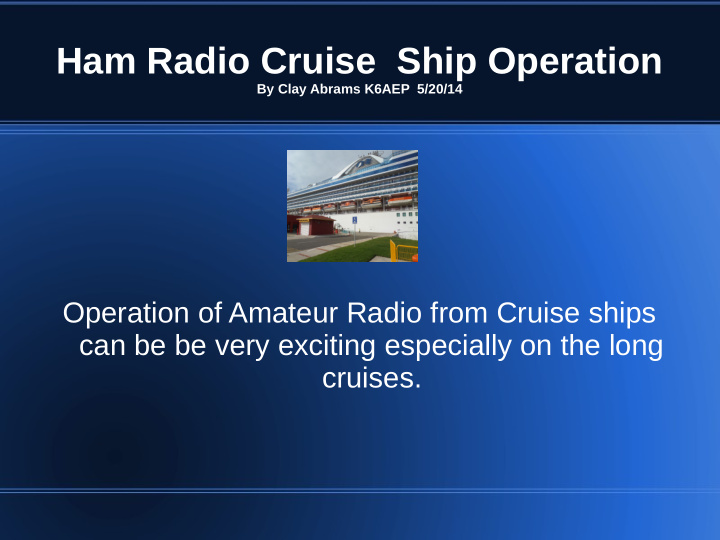



Ham Radio Cruise Ship Operation By Clay Abrams K6AEP 5/20/14 Operation of Amateur Radio from Cruise ships can be be very exciting especially on the long cruises.
Planning for a Cruise Check first with your cruise line. Many cruise lines have a procedure. Two cruise lines which are Ham Friendly are Holland American and Princess. The cruise line representative or sales people can tell you their requirements I used Princess on my last cruise and planning a second one in late August 2014.
Princess (Carnival) Cruise Line Requirements Send a request to a FAX number 661-284-4745 (Anita Sims) Include a copy of your ham license Tell them what equipment you intend to use. One month prior to your departure date you will receive an agreement letter you must sign. Some of the requirements are: − Less than 25 watts of power − Vertical antenna 5 ft or less Optional equipment inspection from the ships crew if they wish. − − Operation only in non-public areas on the ship
Planning for a Cruise Some important things to consider − Where do you plan to operate. What modes do you plan to operate. − − What antenna do you plan to use. Where is you cabin located on the ship. − − What are the HF band conditions like when you leave? All of these points will be discussed in further slides.
Modes of Operation Using SSB can lead to few contacts. − Band conditions are generally very poor this sunspot cycle - 2014. − SSB using QRP can be difficult (at best) or typically impossible. − I tried SSB even on the best conditions experienced for years on 10 meters yielded few contacts using 5 Watts. Using CW is a good choice. Few stations use CW anymore, contacts are more difficult. − I believe Digital modes are the only option for reliable QSO's. − These modes work best using a laptop in a cabin The best mode is PSK31, JT65 second choice (more complex). − − Made 42 QSO's on Hawaii trip (all but 4 were SSB, rest digital).
Band Conditions and Travel Direction Successful operation aboard Cruise ships is largely dependent on location and conditions. − Propagation on current cycle is terrible. QSO's over 2,000 miles difficult. Better chance with 1,200 to 1,500 miles. − Band choices are 10, 15 and possibly 20 meters. Direction of travel of cruise ship makes a huge difference. − My last cruise I was on starboard side. To Hawaii I faced North (i.e. Japan). I had lots of contacts. − On return I faced South America less QSO's, smaller population area. − My next cruise (Trans Atlantic) cabin in Port side, facing south toward Europe and US on return. Should be excellent for QSO's. Distance should be in the 1K plus range.
Location of Ham Operation Best location is on the deck up high, this difficult to do. Not permitted in Public Areas on Princess. Cunard or Carnival. − − Likely have harsh weather, winds, cold/warm or Extreme Sun. Modes of operation limited to SSB others too difficult. − Likely operation will be from a Balcony Cabin or higher class. − Port or Starboard can be important depending on direction of travel. Antenna acts like a beam with less then 180 deg propagation − Antenna may have to be tuned depending on location near metal structures and polarization. − Door opening for coax (slight) will cause a possible breeze which is annoyingly loud or cold breeze.
Antenna Selection Wire or Portable Vertical − Wire antenna not permitted on many cruise lines. − Build vertical or buy? Some buy choices. − MFJ 1899 – widely used best band is 10 meters. CN-32 – Canadian, well constructed must tune OPEK HVT-400B antenna, simple and easy to use. I have and tested all antennas by measurements and on air. − − Found the HVT-400B to be best so far. Have more testing to do using the CN-32
Rigs to use Many choices, mostly what you can afford. Simplest of rigs CW only − Ten Tek HB-1B – small, 5 watts easy to use. Legacy design SSB, CW modes − FT-897 – Battery operation possible SDR rigs leading technology SSB, CW digital modes − KX3 – Very popular, small, built in RTTY, CW, Psk31 and RTTY. Can run on batteries, computer interface easily designed for CAT control and digital communications.
Computers and Software Software can decide what hardware to use. My favorites are: − Psk31, CW, RTTY and other digital modes – FLDIGI JT65 and JT9 - WSJTX − To use all of these modes windows OS is best choice. I used a Lenevo Yoga Pro Win 8.1 laptop which has a 13 inch screen and long battery life. Most any Windows Laptop will function well with FLDIGI and WSJTX. Laptop must have audio in/out and CAT interface.
Hawaii Cruise Ham Setup
Antenna Measurmants I t may be necessary to test the antenna for swr etc when installed. − The effects of near by strictures will effect SWR − It may be necessary to tune antenna A tester I plan to use is a RigExpert AA54 − Device is very portable Easy to use under adverse conditions − − Can measure and adjust at same time
Contact Log At Sea Contacts made during cruise to Hawaii. Total QSO's all modes = 43 SSB totals = 5 PSK31 totals = 27 JT65 Totals = 11 Band conditions - − Two days excellent conditions − Rest normal to poor Location on contacts − USA = 20 − DX (including VE) = 22 (Mostly Asia)
Conclusions Operating from a Cruise Ship is challenging. − Worth the time and effort SSB Operation should not be main mode of − operation. Digital Modes are best way of operation. − − Takes a lot of planning. − Bring all which is light weight and portable.
Recommend
More recommend